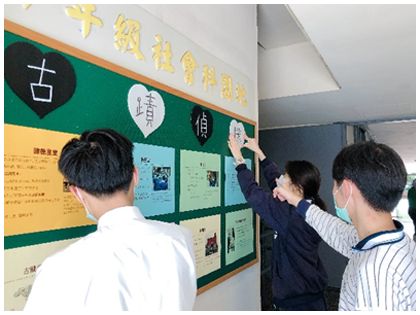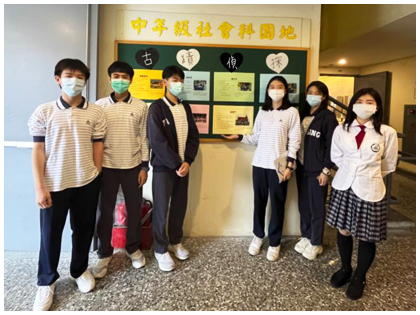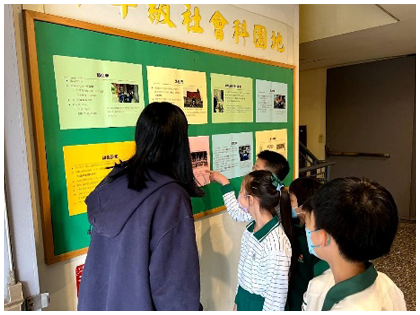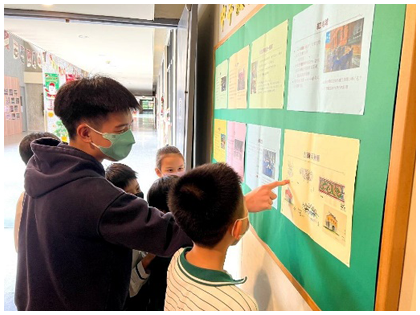Promotion in Campus
(1) Pre-work
During the process of researching Professor Li Chien-Lang and his achievements, we conducted many background investigations and extended information inquiries, but none of this was as memorable as what we learned from the few times we met the professor himself. We sincerely believe that Professor Li Chien-Lang and the knowledge he has brought us about Taiwan’s ancient architecture are very precious and should be more widely known. As the saying goes, “It is better to be happy together than to be happy alone.” The same is true for knowledge and learning, so we decided to organize a series of campus promotion activities and share the essence of our research with teachers and students in the school.
With this goal in mind, we gathered together to discuss the presentation of the campus promotion. Each team member put forward many different plans; we brainstormed and finally settled to make posters and post them on the bulletin board of the primary school section. (Our school provides education from the preschool to the secondary school level.) As a result, all teachers and students who pass by will have the opportunity to have a glimpse of our posters.
|
First of all, we decided how to abridge what we have learned and present the most fascinating parts to the teachers and students at our school. A team member suggested introducing Professor Li Chien-Lang’s books, but then we evaluated that this topic has already been done in the “Book Recommendation” section. To avoid repetition, we vetoed this proposal. Another team member proposed that we introduce different architectural structures, but these details are too cumbersome for campus promotion. After intense discussions, we decided to introduce our research object, Professor Li, six additional monuments we visited on the spot, as well as the paintings that we completed under the instructions of Professor Li. We hope that these diverse presentations will attract the attention of teachers and students in the school. Then, we started to prepare for the decoration of the bulletin board: we took a tape measure to the bulletin board to measure the length and width, which was conducive to the space planning and typesetting of the bulletin board. Next, we went to a stationery store near the school to pick up materials, including quarto colored paper, title boards, markers, double-sided tape, etc. These various tools would come in handy in the poster-making process.

Discussion of Work Division
Source: Detective of Historic sites

Measuring the Bulletin Board
Source: Detective of Historic sites
We divided the work and cooperated to complete an exquisite poster, which included an introduction to Professor Li, the drawings completed by us in the Confucius Temple, and information about the six historical sites that we visited in person. We arrived at school early during the self-study session, went to the bulletin board to take down the old posters, fixed our posters with staples, and explained the information on the posters to the students. The campus promotion work became what we did in our spare time at school and received great feedback.
(2) Poster Layout
After a group discussion, the six of us decided on the content of the campus promotion poster to introduce Professor Li Chien-Lang and his contribution to the maintenance of historic sites, our experience of visiting six historic sites in person, and our hand-painted drawings as the theme. In addition, a short Q&A area is added at the end of each topic. Therefore, students who visit the bulletin board can have a brainstorming time after studying the content of the poster and discussing and interacting with the “detectives” standing guard, who are ready to answer questions from the audience. This will increase the fun and make it easier for the students to remember the knowledge learned. With the cooperation of all of us, we were able to finish the exquisite posters with in-depth contents efficiently.

Temporary Floating Paste Layout
Source: Detective of Historic sites

Measurement and Calculation of the Poster Position
Source: Detective of Historic sites
On the day when the posters were arranged, the six of us arrived at the school early during the morning self-study period. We brought all the tools and the beautifully made posters to the bulletin board, and carefully tore off the old announcement posters for handing them over later. Because we brought a tape measure to the bulletin board to measure the length and width beforehand, we made posters of the right size and planned the layout of the bulletin board in advance, so the layout of the posters went smoothly. Before posting, we roughly planned the positioning of each poster, and one of us stood in the back to visually inspect the alignment and symmetry of the posters, and then we used the double-sided tape prepared in advance to fix it, and the poster layout was done!

Checking Poster Location
Source: Detective of Historic sites

Beautiful Poster Layout Completed
Source: Detective of Historic sites
After completing the poster layout, everyone felt a sense of accomplishment. Unexpectedly, as soon as we took the group photo, many elementary school students flocked to us and were very interested in the content. We immediately divided up the work and interacted with the students and received a great response from the elementary school students. Afterwards, the campus poster promotion and explanation work became the work of our six historic site detectives when we had time after school. We took turns to allocate time to stand on duty and are always looking forward to leading students to learn about these historic sites around us through our efforts, and to promote the concept of historic site maintenance and sustainability.

Six Historic Site Detectives Worked Together to
Complete
the Poster Layout
Source: Detective of Historic sites

Sharing and Promoting Our Research Results to
Intrigued Students
Source: Detective of Historic sites
(3) Promotional Activity
Once our posters were finally completed, we began to think about how to make our research more accessible to elementary school students. Since our posters focus on the history behind Taiwan’s traditional buildings and how to care for them, these concepts might be a bit abstract and difficult to understand for elementary school students in the third and fourth grades. As a result, after a few days of discussions, we decided to verbally introduce our project in detail. Through interaction and explanation, we can achieve the maximum effect of promotion.

Source: Detective of Historic sites

Source: Detective of Historic sites
First, we let the elementary school students read the content on the poster by themselves and then asked them to raise questions about what they did not understand. After that, we introduced to them in detail how Professor Li Chien-Lang introduced the historic sites and drew the hand-drawings. In addition, the posters were printed with many questions and answers about the historic sites we visited. Therefore, we could bridge the concept of treasuring these sites to elementary school students more easily. I believe we all felt a great sense of accomplishment as we watched the team members answer the questions of the students one by one and the bright eyes of the elementary school students when they finally understood the abstract concepts.
| Initially, we thought the elementary school students would not be interested in the topic of “historic sites,” but through the interesting Q&A time and the introduction of the professor’s story, we immediately caught everyone’s attention and made them understand the concept of “sustainability” that we wanted to emphasize. After learning more about the content, the students were very impressed with Professor Li’s contribution to ancient architecture and were very happy to learn that Taiwan has so many precious ancient buildings that tell the tales of Taiwan’s history. Therefore, these buildings should be preserved by human beings so that these stories will be passed on forever. |  Source: Detective of Historic sites Source: Detective of Historic sites |


